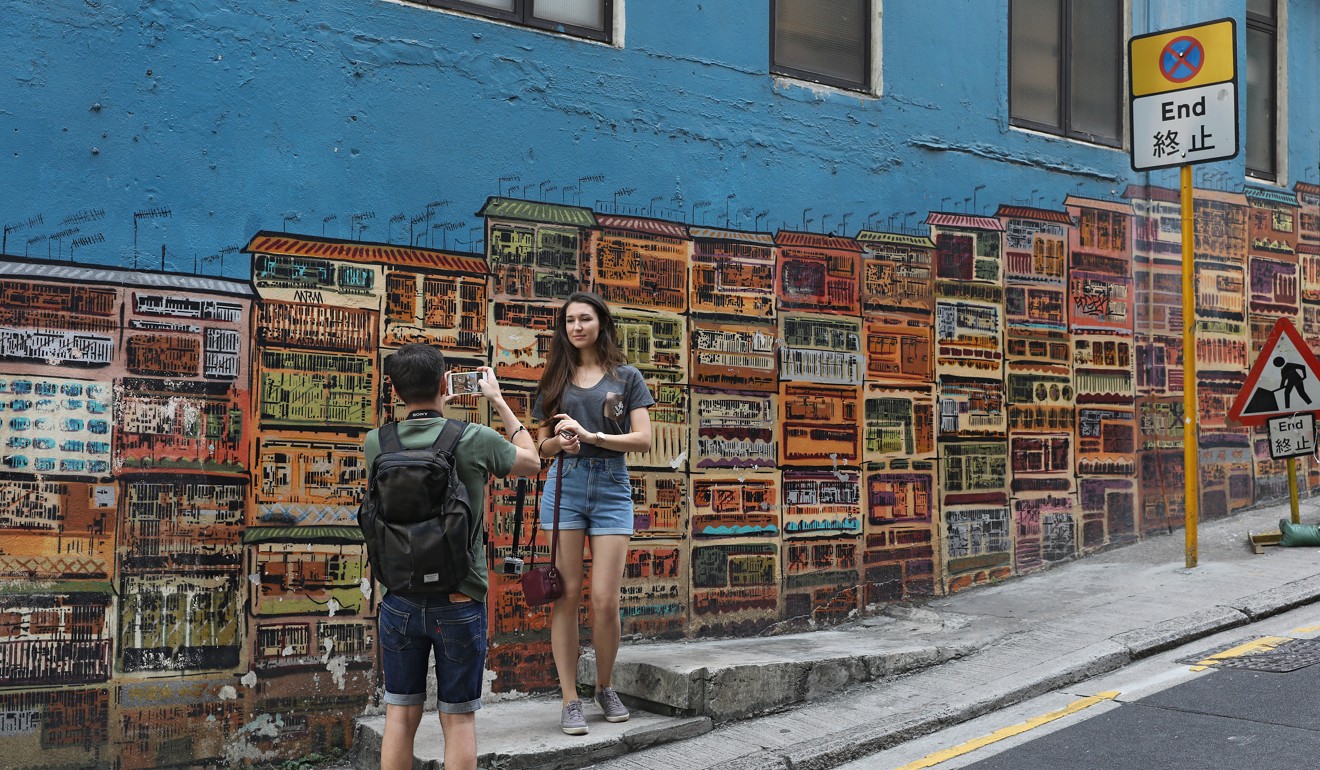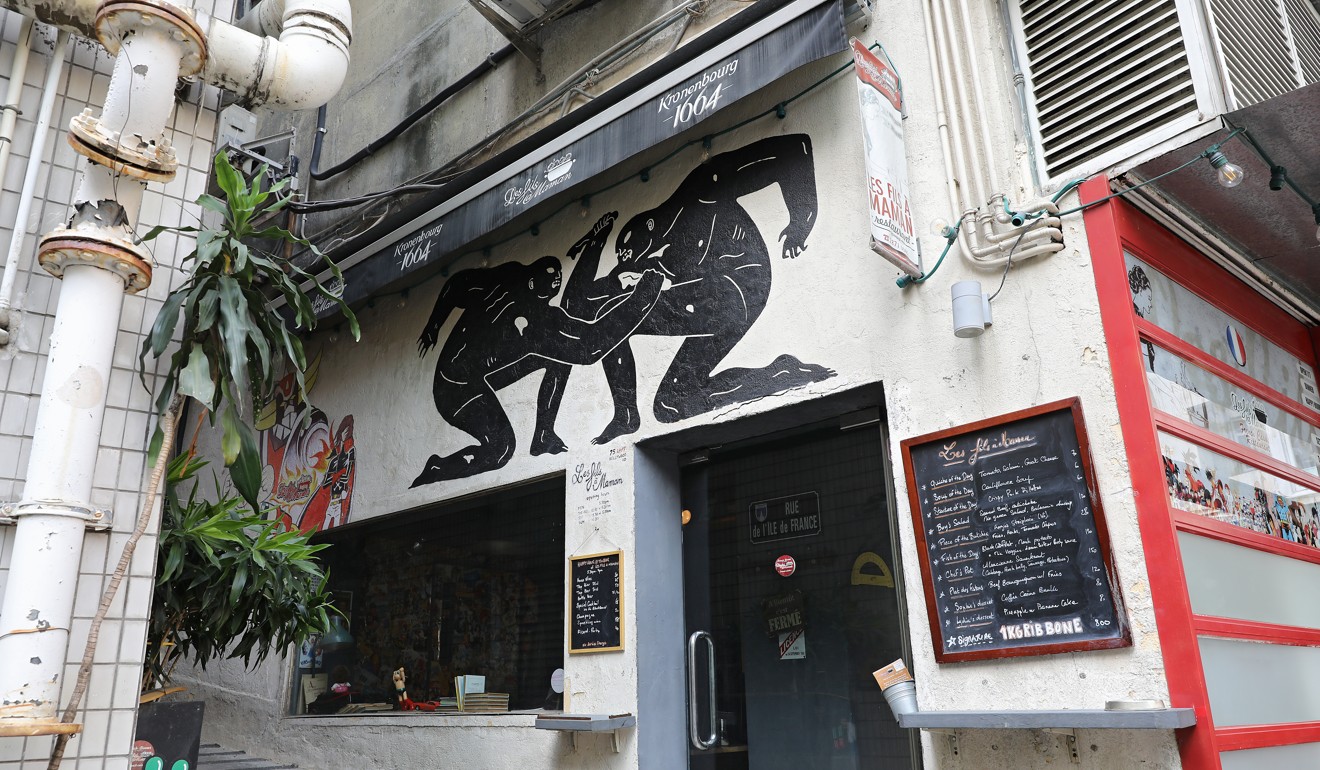
A vibrant art is flowering on Hong Kong’s grey streets
Local street artists hope to bring people together with their work, while others tout the cultural and economic benefits of fostering the scene
It’s early Sunday morning in Soho, and Hong Kong’s popular entertainment zone is still waking up from a night of wild partying, with the smell of alcohol still hanging in the air and barely anyone in sight.
But street art tour guide Diana Chen, wearing a black T-shirt and holding a tablet, is already standing alertly in front of the iconic graffiti wall on Graham Street, ready to kick off her hour-long tour.
Chen, a 27-year-old American who has called Hong Kong home for six years, is the art consultant and street art tour leader for the group Accidental Art, which aims to “connect art lovers, artists and galleries”.
The group started to organise street art tours about a year and a half ago, Chen says, as there is more and more street art emerging in the city, especially in Soho, where her English-language tours are based. A tour can take up to 12 participants. Most are tourists.

“We try to do it in a more unconventional way in the sense that it’s not just an art gallery that you walk into, but with some kind of guidance and interactions,” she says.
Chen describes Hong Kong’s street art scene as “very diverse” with international artists dominating the field, though the number of local artists is growing.
“On my tour, we talk to about 10 to 12 artists from all over the world,” she says. “I’d say there’s definitely six to seven countries represented by the artists.”
“It’s making Hong Kong a bit more hip and more cool in the sense that it’s not just a finance hub or just about real estate. There’s actually a culture here. Even though it’s not necessarily created by Hong Kong artists, it is contributing to the feel and vibes of Hong Kong and its culture.”
The timeless debate over what constitutes street art in Hong Kong and what’s next for the city’s emerging artists
In a city often known for concrete and glass skyscrapers, the rise of street art by local and international artists is adding a splash of colour, revitalising the community and promoting an appreciation of art.
Artists say law-abiding Hong Kong has been more accepting of street art, especially graffiti, which can sometimes be seen as a symbol of rebellion, in the past few years.
A change in attitude
In 2014, an amusing mosaic tile work depicting Pac-Man – located between Tin Hau and Fortress Hill and created by the anonymous French artist Invader – was removed by the government for “safety reasons”. The move sparked outrage among not just the arts community but also internet users fond of Invader’s works.
“They are more receptive to my art,” he says of the officials.
Watch: Where do these mysterious mosaics come from?
Echoing his views, Hongkonger Wong Kin-ho, better known as “Devil Graffiti”, says more graffiti artists like him have been invited to take part in government projects.
Wong, who used to be a baker but quit his job two years ago, now makes money by decorating the exterior walls of local shops.
Some of his recent painting projects include the shutters of a dried seafood store, a cha chaan teng and a joss paper shop. The shop job was in June and formed part of the community art project HK Urban Canvas, which aims to build community through oral history.
The 34-year-old artist says he is not “very good at verbal conversation” but that taking part in different projects and events enables him to get better acquainted with people. “That’s what I want to achieve through graffiti.”

Open dialogue
Gary Yeung Fuk-chi, co-founder of Urban Sketchers Hong Kong, says creating art on the streets is a way to spur dialogue.
“As an urban sketcher, I go into the neighbourhood and the community,” the full-time art teacher explains, noting that the experience is unlike creating in a studio.
It’s important to know that, through art, we can also open a dialogue with people around us
“I observe. And through observations, I get to know more about things in front of me in a much deeper way.”
Yeung, who started sketching eight years ago, recalls how he met an old woman at a quiet seafront village in Sai Kung a year ago. He was sketching a red flowering tree in front of him.
“I was drawing the Delonix [or fame tree] when the woman stopped by,” he says. “She then told me the tree was actually planted by her husband 30 years ago when they got married. And then we started chatting. It’s important to know that, through art, we can also open a dialogue with people around us.”
“Sometimes people come to me and say they know how to knit, too,” she says. “Knitting nowadays is not only about making a scarf or clothes for ourselves. It’s about bringing people together.”
A space for tourism

When it comes to turning edgy art into cash, New Zealand arguably leads the pack, enhancing the country’s popularity while bringing in revenue.
A street art festival in the city of Tauranga from March to June this year helped expand the region’s GDP by NZ$691,000 (more than HK$3.7 million), according to its city council.
The festival, named Paradox, drew over 10,000 visitors. Nearly half came from outside the city.
The council claimed visitors’ spending injected a total of NZ$1.2 million into the region – a significant return on investment for the NZ$115,000 project.
Citing Germany and Italy as examples, Pratt says local officials can promote the creative scene on the streets by allocating space for young artists to express themselves, which could potentially turn into a tourist attraction.
He says street art could help diversify local tourism to show the world Hong Kong is not just a shoppers’ destination.
Hong Kong law is clear: there’s no debating the legality of street art
While Hong Kong seems to be embracing street art, things were not always so rosy between officials and those who see the city’s streets as an open canvas.
In one of the more high-profile cases, French street artist Zevs stuck a stencil of the Chanel logo on Armani’s storefront at the Chater House building and poured water-soluble paint over it on a summer night in 2009, saying he wanted to challenge the brand’s identity.
While some may see the move as high-spirited and artistic, authorities at the time were not as appreciative. The Parisian, whose real name is Christophe Schwaz, was given a two-week suspended sentence for his act in the law-abiding city.
“Graffiti is no doubt a form of art,” barrister Albert Luk Wai-hung says. “But the spirit of the law is that you have to do it in the right place with the owners’ approval.”
In Hong Kong, anyone who defaces a rock or road cutting in or near a public place, or defaces any building, wall or fence with chalk or paint without the consent of the owner, is in violation of the nuisances and miscellaneous offence. Those convicted could pay a fine of HK$500 or face three months surrounded by walls.
“From a legal point of view, graffiti is regarded as damaging private and public properties,” says Luk. “Of course artists would think it is a way of expression, but those affected would consider it as criminal damage. And in Hong Kong, street art is vandalism.”
But many artists think otherwise.
But the nature of street art can be antiauthoritarian, and sometimes the form crosses over into vandalism, according to Gary Wong Pui-fung, a sociology lecturer at the University of Hong Kong.
“Many street artists use their art to battle against mainstream ideas,” says Wong. “It’s really hard to draw a line between street art and vandalism because, the Hong Kong law, whether you agree or not, does not allow street art.”
So, should the law be changed given the rise of street art in Hong Kong?
Wong doesn’t think so. “Street art contains an element of resistance,” he says. “It would render the art form meaningless if we relax the law.”
Three street artists that call Hong Kong home
Tsang Tsou Choi (also known as “King of Kowloon”)
Background: The late Tsang, who was born in Guangdong in 1921, was known for his Chinese calligraphy graffiti. He started to graffiti in the 1950s in Hong Kong. On crutches, he would hobble around the city shirtless and holding a plastic bag of brushes and ink, which he used to write on walls, lamp posts, switch boxes and postboxes across the city. Dubbed as “King of Kowloon”, Tsang had claimed that Kowloon belonged to his ancestors, although there was no proof so far. Tsang died of heart attack in 2007.
Achievements: In 2011, Hong Kong curator Joel Chung Yin-chai curated the exhibition “Memories of King Kowloon” at Artistree, Taikoo Place. Some of his work has been acquired by the M+ museum in West Kowloon. The same year, a buyer paid a record HK$800,000 for a rare piece of calligraphy by Tsang in a Sotheby’s sale.
Szabotage
Background: The award-winning street artist, who is originally from London and now based in Hong Kong, moved here to “depict his vision of this unique 21st century city”. He says on his website that he has been inspired by Hong Kong’s iconic style of urban architecture and emotive streetscapes. His work and subjects are often a mix of popular culture and vivid use of bold colours, exploring themes of personal freedom.
Achievements: The former East London resident’s show credits include a sold-out exhibition in London. Szabotage has painted for HKwalls Street Art Festival and was a finalist in the premier live art event Secret Walls, where he became renowned for his old-school graffiti and onstage antics. Last year, Szabotage held an exhibition in California Tower in Lan Kwai Fong, Central.
Simple Bao
Background: Hong Kong-born Bao is a former graphic designer. She started her street art career in 2015, and her graffiti artworks can be seen mainly in Central, Sheung Wan and Stanley. She says on her website that she mainly loves freestyle work with murals and illustrations.
Achievements: Bao was the champion of street art contest Secret Walls Hong Kong Series 3 last year. She has travelled and worked on projects in all corners of the globe including Australia, Taiwan, mainland China, Japan, Indonesia, Italy and Czech Republic. She has collaborated with many international brands such as Microsoft and Google.

